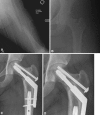Ipsilateral proximal femur and shaft fractures treated with hip screws and a reamed retrograde intramedullary nail
- PMID: 24014269
- PMCID: PMC4117883
- DOI: 10.1007/s11999-013-3271-5
Ipsilateral proximal femur and shaft fractures treated with hip screws and a reamed retrograde intramedullary nail
Abstract
Background: Although not common, proximal femoral fractures associated with ipsilateral shaft fractures present a difficult management problem. A variety of surgical options have been employed with varying results.
Questions/purposes: We investigated the use of hip screws and a reamed retrograde intramedullary (IM) nail for the treatment of this combined fracture pattern in terms of postoperative alignment (malunion), nonunion, and complications.
Methods: Between May 2002 and October 2011, a total of 95 proximal femoral fractures with associated shaft fractures were treated at three participating Level 1 trauma centers; all were treated with hip screw fixation (cannulated screws or sliding hip screws) and retrograde reamed IM nails. The medical records of these patients were reviewed retrospectively for alignment, malunion, nonunion, and complications. Followup was available on 92 of 95 (97%) of the patients treated with hip screws and a retrograde nail. Forty were treated with a sliding hip screw, and 52 were treated with cannulated screws.
Results: There were five proximal malunions in this series (5%). The union rate was 98% (90 of 92) for the femoral neck fractures and 91.3% (84 of 92) for the femoral shaft fractures after the initial surgery. There were two nonunions of comminuted femoral neck fractures after cannulated screw fixation. There was no difference in femoral neck union or alignment when comparing cannulated screws to a sliding hip screw. Four open comminuted femoral shaft fractures went on to nonunion and required secondary surgery to obtain union, and one patient developed symptomatic avascular necrosis.
Conclusions: The treatment of ipsilateral proximal femoral neck and shaft fractures with hip screw fixation and a reamed retrograde nail demonstrated a high likelihood of union for the femoral neck fractures and a low risk of malunion. Comminution and initial displacement of the proximal femoral fracture may still lead to a small incidence of malunion or nonunion, and open comminuted femoral shaft fractures still may progress to nonunion despite appropriate surgical management.
Level of evidence: Level IV, therapeutic study. See Instructions for Authors for a complete description of levels of evidence.
Figures




Similar articles
-
Retrograde nailing with subsequent screw fixation for ipsilateral femoral shaft and neck fractures.Arch Orthop Trauma Surg. 2006 Sep;126(7):448-53. doi: 10.1007/s00402-006-0161-2. Epub 2006 Jun 21. Arch Orthop Trauma Surg. 2006. PMID: 16810555
-
Ipsilateral femoral shaft and neck fractures: are cephalomedullary nails appropriate?J Surg Orthop Adv. 2011 Summer;20(2):122-5. J Surg Orthop Adv. 2011. PMID: 21838074
-
Cephalomedullary screws as the standard proximal locking screws for nailing femoral shaft fractures.J Orthop Trauma. 2010 Dec;24(12):717-22. doi: 10.1097/BOT.0b013e3181f6bfe8. J Orthop Trauma. 2010. PMID: 21076246
-
Ipsilateral fractures of the femoral neck and shaft.J Orthop Trauma. 1992;6(2):159-66. doi: 10.1097/00005131-199206000-00005. J Orthop Trauma. 1992. PMID: 1602335 Review.
-
Appropriate treatment for nail breakage following femur intertrochanteric fractures without additional reduction: case series and literature review.BMC Musculoskelet Disord. 2025 May 9;26(1):454. doi: 10.1186/s12891-025-08669-x. BMC Musculoskelet Disord. 2025. PMID: 40346578 Free PMC article. Review.
Cited by
-
A comparison of the incidence of concomitant ipsilateral femoral neck fractures in ballistic versus blunt femur fractures.Eur J Orthop Surg Traumatol. 2023 May;33(4):843-850. doi: 10.1007/s00590-022-03219-w. Epub 2022 Feb 5. Eur J Orthop Surg Traumatol. 2023. PMID: 35122540
-
Ipsilateral femoral neck and shaft fractures: case series from a single Level-I trauma centre and review of literature.Eur J Orthop Surg Traumatol. 2023 May;33(4):803-809. doi: 10.1007/s00590-021-03199-3. Epub 2022 Feb 4. Eur J Orthop Surg Traumatol. 2023. PMID: 35119486 Review.
-
Surgical management of bifocal femoral fractures: a systematic review and pooled analysis of treatment with a single implant versus double implants.Arch Orthop Trauma Surg. 2023 Oct;143(10):6229-6241. doi: 10.1007/s00402-023-04950-7. Epub 2023 Jul 5. Arch Orthop Trauma Surg. 2023. PMID: 37405462 Free PMC article.
-
Treatment of ipsilateral femoral neck and shaft fracture by augmented fixation via modified anterior approach: A case report.Trauma Case Rep. 2022 Apr 27;39:100650. doi: 10.1016/j.tcr.2022.100650. eCollection 2022 Jun. Trauma Case Rep. 2022. PMID: 35571578 Free PMC article.
-
Single lag screw and reverse distal femur locking compression plate for concurrent cervicotrochanteric and shaft fractures of the femur: biomechanical study validated with a clinical series.Eur J Orthop Surg Traumatol. 2021 Aug;31(6):1179-1192. doi: 10.1007/s00590-020-02868-z. Epub 2021 Jan 8. Eur J Orthop Surg Traumatol. 2021. PMID: 33417049
References
-
- Alho A. Concurrent ipsilateral fractures of the hip and shaft of the femur: a systematic review of 722 cases. Ann Chir Gynaecol. 1997;86:326–336. - PubMed
-
- Bali K, Gahlot N, Aggarwal S, Goni V. Cephalomedullary fixation for femoral neck/intertrochanteric and ipsilateral shaft fractures: surgical tips and pitfalls. Chin J Traumatol. 2013;16:40–45. - PubMed
-
- Bennett FS, Zinar DM, Kilgus DJ. Ipsilateral hip and femoral shaft fractures. Clin Orthop Relat Res. 1993;296:168–177. - PubMed
Publication types
MeSH terms
LinkOut - more resources
Full Text Sources
Other Literature Sources
Medical
Research Materials

